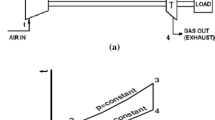Abstract
In practice of natural gas energy custody transfer using orifice flow meter, the result was calculated based solely on the measured pressure drop resulted by the orifice disk in the flow line. Therefore, the total energy that was delivered in custody transfer was calculated based on adiabatic condition, i.e., an ideal condition of the gas flow rate. Using the orifice flow meter in such condition has weakness on its accuracy. To improve its accuracy, the delivered energy using orifice flow meter system should be calculated by considering non-adiabatic condition, which was influenced by thermodynamic parameter such as compressibility factor (Z), internal energy (U), enthalpy (H) and other energy components. In this research, it has been shown that in non-adiabatic condition the flow rate of energy (Q) was not linear with the increasing of temperature of the environment. This research was started by constructing a mathematical model of energy flows under conditions of both adiabatic and non-adiabatic condition in an orifice flow meter measuring system. The calculated flow rate of energy \( ( {\dot{Q} } ) \) in non-adiabatic condition was highly determined by the internal energy (U) and enthalpy (H). In the non-adiabatic condition, the calculated flow rate of energy was affected by environment temperature. This temperature influenced the internal energy (U) and enthalpy (H). The values of U and H in this measurement were not linear. The average of calculated flow rate of energy \( ( {\dot{Q} } ) \) increases 0.67 Mmbtud by the increasing of 1 K of temperature. The difference of the flow rate of energy of the natural gas in non-adiabatic conditions (in the operational temperature of 298 K) was 5 % higher than in adiabatic condition.







Similar content being viewed by others
References
AGA 3, Orifice flow metering of natural gas and other related hydrocarbon fluids3: natural gas applications, 3rd ed., American Gas Association, Arlington (1992).
M. Farzaneh-Gord, A. Khamforoush, S. Hashemi and H.P. Namin, Computing thermal properties of natural gas by utilizing AGA8 equation of state, Int. J. Chem. Eng. Appl., 1(1) (2010) 20–24 (ISSN: 2010-0221).
J.L.G. Oliveira, J.C. Passos, R. Verschaeren and C.V.D. Gerd, Mass flow rate measurements in gas–liquid flows by means of a venturi or orifice plate coupled to a void fraction sensor, J. Exp. Therm. Fluid Sci., 33(2) (2008) 253–260.
Complete Draft of Recommendation (R) 137, Gas meter, Organization Indernationale De Legal Metrologie (OIML), The Netherlands (2009).
S. Richard and H. Andrew, Effects of wet gas on orifice plate gas meter, J. Exp. Therm. Fluid Sci., 20(4–5) (2009) 141–151.
Z. Hong-jian, Y. Wei-ting and H. Zhi-yao, Investigation of oil-air two-phase mass flow rate measurement using Venturi and void fraction sensor, J. Zhejiang Univ. Sci., 6(6) (2004) 601–606 (ISSN 1009-3095).
A. Naveenji, S. Malavarayan and M. Kaushik, CFD analysis on discharge coefficient during non Newtonian flows through orifice flow meter, Int. J. Eng. Sci. Technol., 2(7) (2010) 3151–3164.
W. Jianhuaa, A. Wanzheng and Z. Qi, Head loss coefficient of orifice plate energy dissipator, J. Hidrolik Res., 48(4) (2010) 526–530.
N.S.L. Rao and K. Sridharan, Loss characteristic of long orifice, Fourth conference on hydraulic and fluid mechanic, Monash University, Australia (1971).
AGA 5, Calculation of gross heating value, relative density and compressibility factor for natural gas mixtures, March 2002.
J.M. Smith, M.M. Abbott and H.C. Van Ness, Introduction to chemical engineering thermodynamics, 5th ed., The McGraw-Hill Companies, Inc, Singapore (1996).
B.R. Bird and E.W. Steaward, Transport phenomena, 2nd ed., John Wiley and Sons, Inc, New York (2001).
W.L. McCabe, J.C. Smith and P. Harriott, Unit operation of chemical engineering. Chemical engineering series, 5th ed., McGraw-Hill, New York (1993) (ISBN 0-07-044844-2).
M.J. Prausnitz, Properties gases and liquid, 5th ed., The McGraw Hill Company, New York (2001).
AGA 8, Compressibility and super compressibility for natural gas and other hydrocarbon gases, Transmission measurement committee report no. 8., AGA Catalog No. XQ 1285, Arlington, VA, 1992.
Acknowledgments
The authors would like to thank the Metrological Center for Development of Human Resources and the Directorate of Metrology, Ministry of Trade who has provided an assistances and facilities for the data collection of this research.
Author information
Authors and Affiliations
Corresponding author
Rights and permissions
About this article
Cite this article
Gunawan, Tjokronegoro, H.A., Leksono, E. et al. Nonadiabatic Condition on the Natural Gas Energy Custody Transfer Using Orifice Flow Meter. MAPAN 30, 77–84 (2015). https://doi.org/10.1007/s12647-015-0132-6
Received:
Accepted:
Published:
Issue Date:
DOI: https://doi.org/10.1007/s12647-015-0132-6




